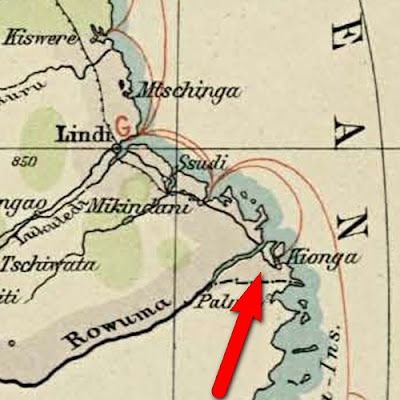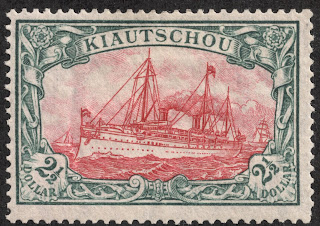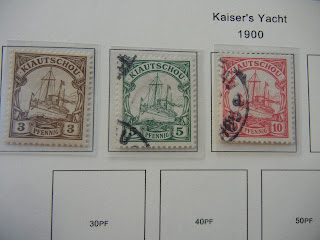1902 Scott 34 3ch orange "Emperor's Crown"
40th year of Reign of Emperor Gojong
Quick HistoryThe Korean Empire, succeeding the Joseon Dynasty (1392-1897), was proclaimed in 1897, and lasted until the invasion of Imperial Japan in 1910. On August 22, 1910, Japan annexed the Korean peninsula.
Map of Great Korean Empire
The Joseon Dynasty was under the influence of China for centuries, but came under Japanese hegemony in 1895. Administrative control by Japan was assumed in 1904, and all Korean stamps were withdrawn by 1905. Stamps of Japan were used in Korea from 1905-1946.Stamps of Korea (or Corea) were issued from 1884-85, and then, from 1895-1903.
The alternative name for Korea- "Tai Han" was used for a few years after 1897.
The Capital was Seoul (Although concurrently, it was known as Hanesong (Josean era), Keijo (Japanese- 1907-1945), and Gyeongseong (Korean). Korea's population was 22,000,000 in 1938.
Korean Peninsula
Note: re"Yellow Sea" and "Sea of Japan"?
Note: Koreans today prefer the names"West Sea" and "East Sea" respectively
Note: re"Yellow Sea" and "Sea of Japan"?
Note: Koreans today prefer the names"West Sea" and "East Sea" respectively
Obviously, for the Korean peninsula, much changed following the defeat of Japan in WW II. After the 1950-53 Korean War, Korea has remained divided between North Korea and South Korea.
1885 Scott "4" 50m green
Not placed in use
Into the Deep BlueThe 2011 Scott Classic Specialized catalogue has, for Korea 1884-1903, 55 major descriptive numbers. Of those, 17 are $10 or less (31%).
Clearly, Korea is moderately expensive for WW classical collectors.
100 Mon = 1 Tempo
5 Poon = 1 Cheun
100 Sen = 1 Yen
1000 Re = 100 Cheun = Weun
A closer look at the stamps and issues
1884 Scott 2 10 mon blue "Yin Yang"
The first stamps was issued in November 1884 during the Joseon dynasty. But the Post Office was burned down (Gaspin Coup) in December 1884, so only the 5m rose and 10m blue of the issue were used, and then, not much.
So one will find the 5m and 10m unused in collections (CV $10+-$50+). Scott states there are counterfeits and reprints.
Three more stamps were printed, but not issued. What happened to them?
1885 Scott "5" 100m blue & pink "Yin Yang"
Not placed in use
As one could guess, the three unissued stamps also entered the philatelic mainstream. They are listed in my 1947 Scott catalogue with a notation that they were never placed in use.
But the current catalogue has delisted them (Scott 3-5), but does have an illustration, as well as a value ($4-$8).
Frankly, they are such gorgeous classically designed stamps, I can see why they have remained popular, and can be found commonly in collections.
1895 Scott 9 50p purple (II) "Yin Yang"
No new stamps were issued for 10 years. Then, in 1895, a four stamp set, as illustrated, was produced (CV $10+-$20+).
Note the Type II 50p purple has a period after the "50", while the Type I does not.
Taeguek
The stamps have in their center design a Taegeuk symbol. The design is found as early as the 7th century from excavations in Korea.
The symbol refers to an ultimate reality from which all things derive.
1897 Scott 13 50p purple, red overprint
"Tae Han"
The preceding issue of four stamps were overprinted "Tae Han" in 1897 (CV $10+). "Tae Han" essentially means "Korea", which is the westernized name.
1900-01 Scott 22 4ch carmine, perforation 11
The Korean Empire had a change in currency to Re/Cheun/Weun in 1900, and consequently, a new 14 major number set was issued (CV $3+-$10+ for 11 stamps).
Scott has the major numbers as perforation 11, save for the Scott 20 2ch blue, which is perforation 10.
Be aware there is also a 2ch pale blue (Scott 20B) with a different design.
1900-01 Scott 21b 3ch orange red, perforation 10
There are also nine minor numbers listed by Scott with perforation 10. Fortunately, as they are almost as common as the major number perforation 11 stamps, the Steiner (Deep Blue) has additional spaces for them.
For BB collectors, check to see if the stamp is perforation 10 or 11.
1902 Scott 34 3ch orange "Emperor's Crown"
For the 40th year of the reign of Emperor Gojong, this strikingly designed stamp was issued in 1902. This stamp was also used for the post header. ;-)
Note the Latin script is in French, rather than English.
Emperor Gojong was forced to abdicate by the Japanese in 1907, and his son, Sunjong, assumed the Emperor role.
1903 Scott 39 2re slate "Falcon"
The last classic Korean issue was produced in 1903, and has 13 stamps in the set (CV $6+-$10+ for 8 stamps). Note the "Seoul" postmark on the illustrated stamp.
The "Falcon" long has been a symbol of elegant prowess.
By 1905, the Korean and Japanese postal systems were amalgamated, and Korean stamps were no longer issued.
Deep Blue
My Deep Blue (Steiner) album has four pages for classical Korea. As mentioned, the Steiner also provides spaces for the nine minor number perforation 10 stamps of the 1900-01 issue.
1900-01 Scott 18 2re gray
Big BlueBig Blue '69, on one page, has 26 spaces. Coverage is 45%.
BB clearly has a nice selection, considering the moderately expensive nature of the stamps.
Note the country is under "Korea" in the '69 and '97 editions, and under "Corea" in the '41/'43'47 editions.
Observations...
• BB does have spaces for the three 1885 stamps that were never placed in use. Remember that Scott no longer lists these stamps ( Scott "3","4","5"). But the stamps are often found in collections, and have great Korean classical designs. So, O.K. with me. ;-)
• As one would expect with the higher Korean CV prices, BB has spaces for nine stamps with $10+-$20+ valuation. None cross the $35 "Most Expensive" threshold, though.
• Be aware that the 1900-01 issue is found with perforation 11 (major), and perforation 10 (mostly minor) varieties. Check your stamps.
Checklist
1884-85*
2,"3","4","5",
1895
6,7,8,9,
1900
18,19,20,21,22,23,24,
1901-02
20B, 35,36,37,34,
1903
39,40,41,42,(43),(44),
End
Comments
A) Expensive stamps ($10 threshold):
1884 Scott 2 10m blue ($10+)
1895 Scott 6 5p green ($10+)
1895 Scott 7 10p deep blue ($10+)
1895 Scott 8 25p maroon ($20+)
1895 Scott 9 50p purple (10+)
1900 Scott 20 2ch blue ($10+)
1900 Scott 22 4ch carmine ($10+)
1902 Scott 34 3ch orange ($10+)
1903 (Scott 44) 5ch yellow brown ($10+)
B) ( ) around a number indicates a blank space choice.
C) *1884-85- Scott "3","4","5" are no longer in the catalogue, as these stamps were never placed in use. Nevertheless, they are common in collections.
1903 Scott 40 1ch violet brown "Falcon"
Out of the BlueI have a new favorite country. ;-)
Note: Maps appears to be in the public domain
Links
Korea Bud's Big Blue
I like comments.






























































